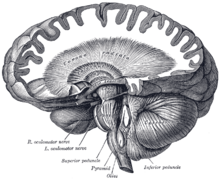 Global Information
Global InformationNeuroferritinopathy information
| Neuroferritinopathy | |
|---|---|
| Other names | Adult-onset basal ganglia disease |
 | |
| Cerebellum and basal ganglia | |
| Specialty | Neurology |
Neuroferritinopathy is a genetic neurodegenerative disorder characterized by the accumulation of iron in the basal ganglia, cerebellum, and motor cortex of the human brain. Symptoms, which are extrapyramidal in nature, progress slowly and generally do not become apparent until adulthood.[1] These symptoms include chorea, dystonia, and cognitive deficits which worsen with age.[2][3]
This disorder is autosomal dominant[4] and is caused by mutations in the gene encoding the light chain subunit of the ferritin protein. Wild type ferritin functions as a buffer for iron, sequestering it and controlling its release. Thus, mutations in the light chain of ferritin result in the accumulation of iron in the brain which can be imaged using MRI.[2] Currently, neuroferritinopathy is the only neurodegenerative disease with an iron accumulation in the brain classified as an autosomal dominant syndrome.[4]
Treatment of neuroferritinopathy is focused on managing symptoms associated with chorea and dystonia using standard medications for each.[2] The disorder is progressive and symptoms become worse with age. Fewer than 100 cases of neuroferritinopathy have been reported since its identification in 2001.[2] Its incidence has been largely localized to Northwest England, significantly in the Cumbria region[4] suggesting a founder effect.[2] Due to its genetic nature, current research is focused on therapeutic management of the symptoms caused by the disorder.[4]
- ^ Lehn, A; Boyle, R; Brown, H; Airey, C; Mellick, G (September 2012). "Neuroferritinopathy". Parkinsonism & Related Disorders. 18 (8): 909–15. doi:10.1016/j.parkreldis.2012.06.021. PMID 22818529.
- ^ a b c d e Chinnery, PF; Pagon, RA; Adam, MP; Ardinger, HH; Bird, TD; Dolan, CR; Fong, CT; Smith, RJH; Stephens, K (2010). "Neuroferritinopathy". PMID 20301320.
{{cite journal}}: Cite journal requires|journal=(help) - ^ Zecca, L; Youdim, MB; Riederer, P; Connor, JR; Crichton, RR (November 2004). "Iron, brain ageing and neurodegenerative disorders". Nature Reviews Neuroscience. 5 (11): 863–73. doi:10.1038/nrn1537. PMID 15496864. S2CID 205500060.
- ^ a b c d Keogh, MJ; Morris, CM; Chinnery, PF (2013). "Neuroferritinopathy". International Review of Neurobiology. 110: 91–123. doi:10.1016/B978-0-12-410502-7.00006-5. ISBN 9780124105027. PMID 24209436.